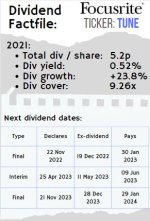
About to start investing for dividends?
Maybe my experiences will help?

London, July 2017
Today I start investing for dividends!
Here goes... I've just hit the "deal" button on my online broker to place my first active investments on the route (I hope) to retiring on dividends in 15 years' time.
My goal is an annual dividend income between £30,000 and £40,000 ($40,000-$55,000), which means I'll need somewhere between £750k -£1m ($1m-$1.35m) in assets. I've sought out advice from some of the finest dividend investors around.
Can I make it? We'll find out...
I'm going to blog at regular intervals along the way, and before I let you know what I chose as I start investing for dividends with my first £21,000 ($28k) and why, I'll lay out the starting position:
1. I'm not starting at zero
I've been saving £500-550 ($675-740) monthly from my salary since 2009. Along the way I've invested that entirely into unit trusts.
Knowing nothing about the market, I thought that was a sensible thing to do (how I wish I had heard about low-cost dividend paying ETFs!) Nevertheless, having started with the unit trusts the year after the Global Financial Crisis, the cash I saved has done pretty well, growing from £50,000 to a little over £80,000.
Some of this has been tied up for the last couple of years in a property renovation project which is shortly going to cash out.
2. I'm 41 years old, so don't have that much time to build my portfolio
My job is pretty stressful so I'm hoping to have the option to retire on £3,500 - £4,000 in monthly dividend income in 15 years' time.
3. I am no financial whizzkid
I have no background in accounting or finance, but I do consider myself to be fairly smart and disciplined with money.
4. I have done a decent amount of research
Not having much of a pension from the start of my career, I've taken saving and investing seriously. I've read books, many of the letters of Warren Buffett and have started interviewing top investors - amongst others Aussie dividend investment guru Peter Thornhill. Beyond that I've quizzed my super-successful dividend investor buddy Mike Roberts for hours (I appreciate it, Mike).
Now as I start investing for dividends, I'm planning to replicate Peter and Mike's model of investing for value, reinvesting dividends and buying and holding the stocks I purchase for the long term. I will view my stock purchases as investments in businesses and will not speculate short-term on price.
I need to start investing for dividends with a simple, repeatable and fairly low-tech approach
... so this is what I plan to do:
1. Use Stockopedia
I'm a big fan of its simplicity. As I start investing for dividends, Stockopedia has been a huge help and I promise you I'm not being paid a dime to say so.
I use its screens and some filters (see below) that my super successful dividend investor buddy Mike has given me to narrow down the list of possible stocks.
2. Do everything I can to avoid companies that go bankrupt
Mike's wise words and Benjamin Graham's classic book "The Intelligent Investor" both place great emphasis on investing in companies which are secure from bankruptcy.
Going all out for flashy growth might be fun, but Ben Graham was clear in his warning that investors who make big returns in "exciting" or "high growth" companies generally lose a similar amount in the one or two companies in their portfolio that go to the wall.
As I start investing for dividends I'm not going to look for super-innovative companies that might catapult me forward to my goal, or might fall flat. I want proven products and proven companies which know how to grow their bottom line reliably.
My guiding principles will be to find companies that seem safe from bankruptcy and are dedicated both to growing their earning power and returning cash to investors through dividends.
3. Buy and hold, not trade stocks
As I start investing for dividends, I plan to build a portfolio of 20-30 companies and ETFs and basically buy and hold them long term.
4. Reinvest ALL the dividends until it's time to retire
That's right - I ain't touchin' a dime until I finish work! Everything from the day I start investing for dividends goes back into buying more income-generating assets.
What I'm not going to do...
Spend time agonising over decisions:
I like quick decisions. I know I'll make some that won't turn out well, but they should hopefully be outweighed by the good ones. What's really important is that I start investing for dividends now, without procrastinating.
Read financial reports
I'm afraid I've got a "thing" about financial reports...
One of my favourite Warren Buffett quotes is: "Some guys read Playboy, I read financial reports".
Although he and my buddy Mike Roberts sing the praises of reading financial reports from the companies you invest in, I don't honestly seem to get too many insights from reading them.
I've tried it and when Mike and I read the same document, he often gets a different message.
He can "see" things in the figures that I can't. That's probably because he's a highly trained financial services professional and I'm not!
I don't seem to be able to make out the genuinely good news from the over-enthusiastic promises and exaggerations like Mike can.
Even after reading the reports, he tells me he still makes mistakes, and picks the wrong companies from time to time, so I figure there are no surefire "right answers" in investing anyways.
Stockopedia: Data I can understand...
In preparing for this investment project, it became clear that I needed a straightforward, yet effective approach to gathering data, so I've turned to Stockopedia. Having looked at this platform for some time, I've signed up for the market I'm focussing on and I've been impressed with the simplicity and accessibility of the data. See a full Stokopedia review here...
My plan of action...
- Diarize ONE HOUR of my time at the beginning of each month to decide on next investments
- Never check my investments other than on that day.
- Drip feed my current cash into investments over time (to take advantage of dollar-cost-averaging).
- Use my UK ISA (roughly equivalent to a US Roth IRA) to enjoy as much of the growth and dividend income as possible tax free.
- Leverage the mortgage on my house to give me access to extra funds to invest. Click here for more details.
- Never invest in chunks smaller than £1,000 to reduce the impact of dealing costs.
The in-depth interview with Peter Thornhill, and my research reading Warren Buffett's letters to investors all indicate that the timing of your purchases make a big difference. But they also say that there's no way of knowing when the next dip in the market will come, nor how far prices will fall, so it's best simply to get started and invest regularly to smooth out the ups and downs, whilst having some cash in reserve to pick up bargains in the dip times.
That's what I'm going to do...
I will convert my unit trusts and {property investment} to cash and invest it at regular intervals in the first couple of years, which is how long it will take due to limits on the amount I can bring into my UK ISA each year.
Using your mortgage to get greater leverage:

Interviewing Peter Thornhill has given me the inspiration to look at leveraging the equity in my house to give me access to funds to start investing in solid dividend producing stocks in greater volumes and hold that cash in the market for longer.
His method is to take a line of credit against your property, invest in dividend generating assets and then use those to pay down the mortgage (all the details are here). Unfortunately this kind of loan is not available to me living in the UK.
However, if you're a homeowner and have more than the minimum down-payment you need for the property you own or are looking to buy, and you're diverting part of your salary into investments you can do roughly the same thing using a an all-in-one home loan or even a regular mortgage. Read more here.
Mike's magic filters
And finally, here are the 3 magic filters Mike Roberts shared with me and my first stock picks:
Mike's words of advice were simple: "don't look at any stock that fails to meet these criteria":
- Net debt of less than 0 (i.e. the company must have greater assets than debt)
- Average ROE (return on equity) in the last 5 years of more than 15% (i.e. the company must have made a gross profit of more than 15% on each dollar of shareholder capital invested in the business).
- Dividend Yield of more than 4% (i.e. the company has returned more than 4% of the share price in the last 12 months in dividends to investors).
What I invested in:
Here are the stocks / ETFs I picked to buy in July 2017 (please remember this do not represent investment advice - see our Privacy and Legal pages for the site's terms of use):
|
Ticker |
Company |
Sector |
Investment |
These were companies that fulfilled as many of the Stockopedia screens as possible, met Mike's magic filters and looked solid, dependable and interesting to my untrained eye.
Today I start investing for dividends; let's see how they do in the coming months and years. I'll blog about them in future, I'm sure.
Let me know what you think about my first choices and investing principles, by commenting below...

